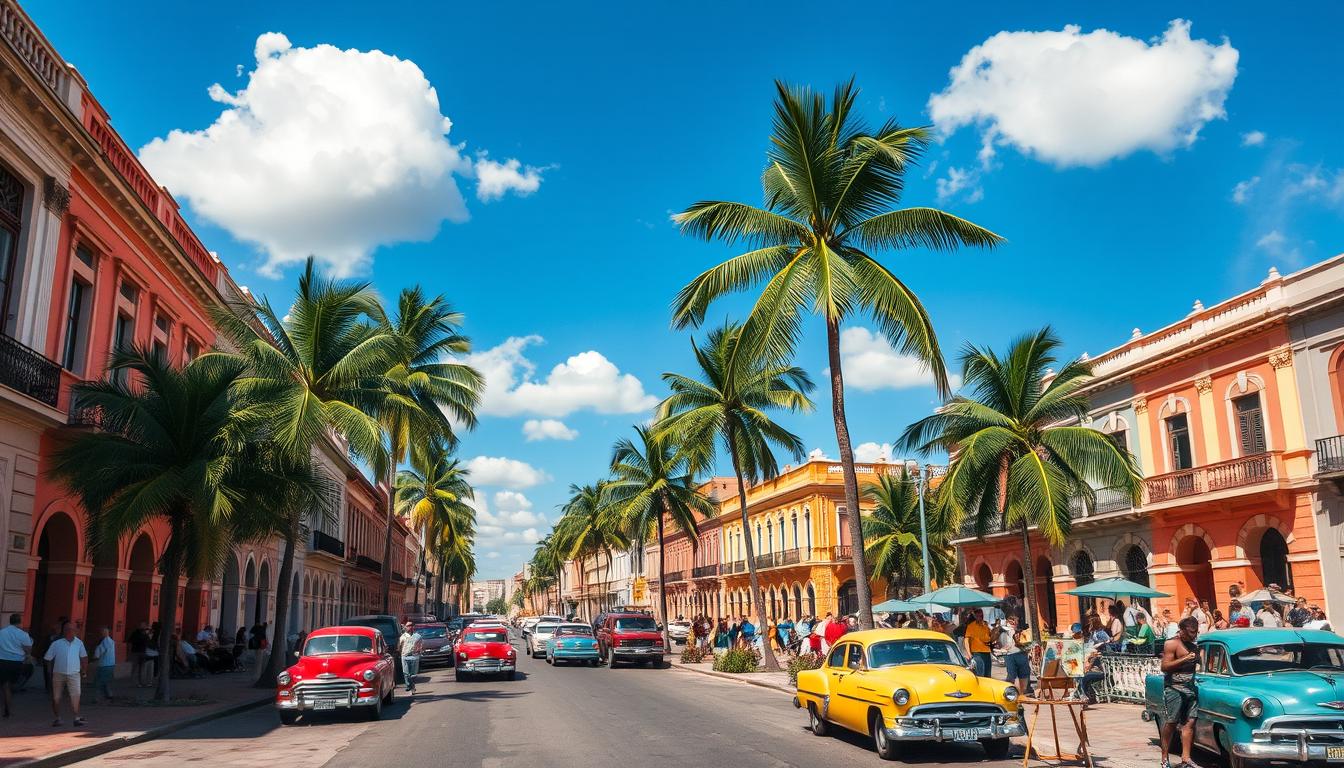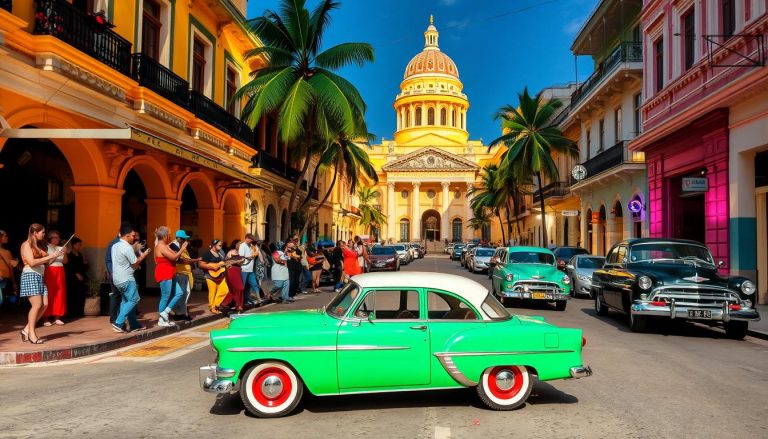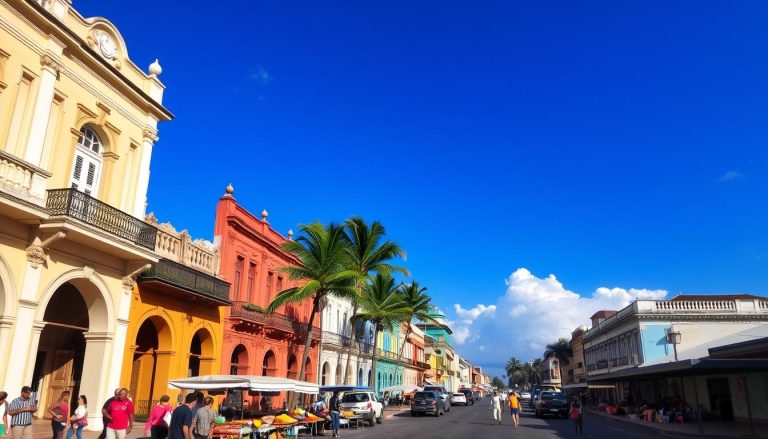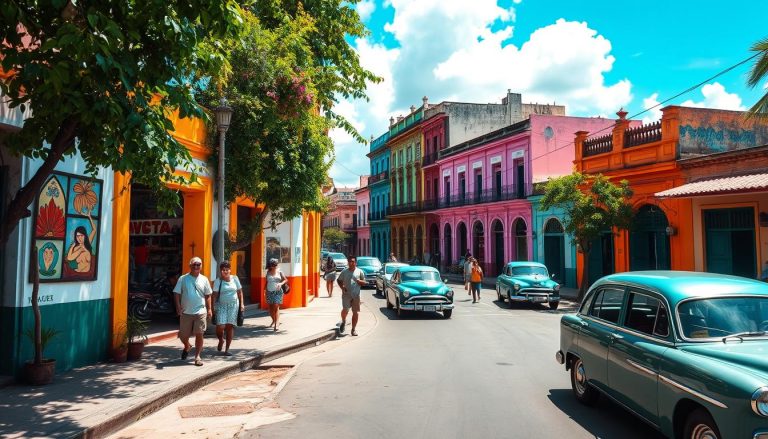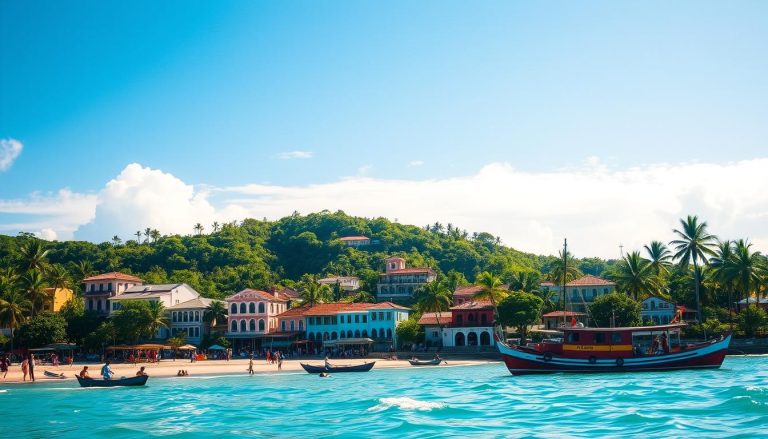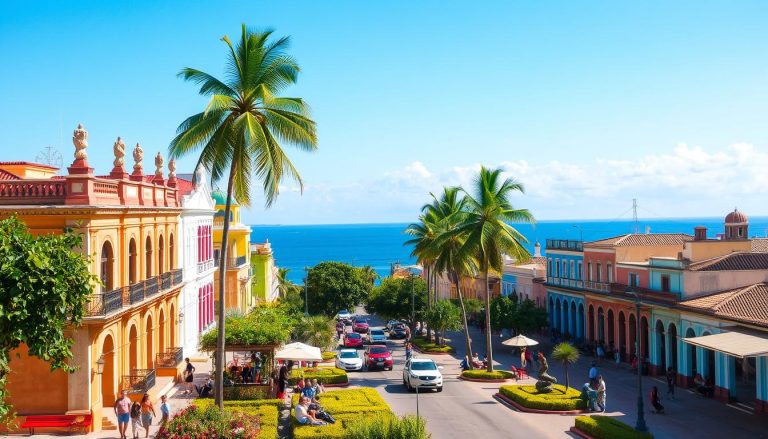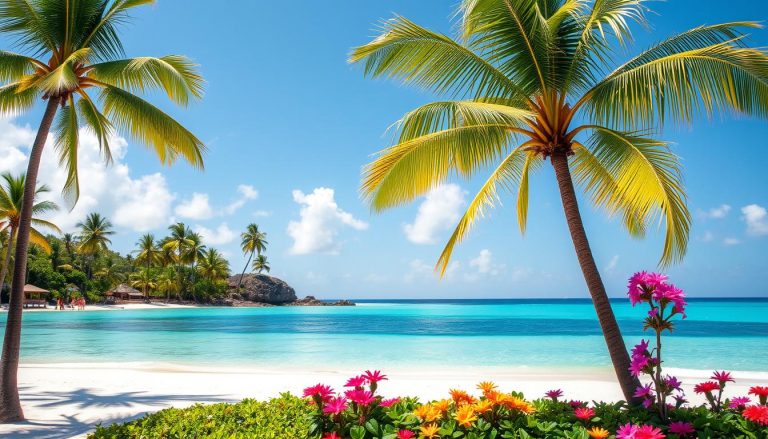Are you ready to explore Cuba’s vibrant heart? Welcome to Havana, a city that celebrates 500 years of history and culture. You’ll see vintage American cars and UNESCO-protected colonial architecture. Havana is a mix of old and new that draws visitors from everywhere.
Havana is known as the “Key to the New World.” It’s where cultures meet, blending Spanish, African, and Caribbean traditions. You can dive into the arts and music, follow Ernest Hemingway’s footsteps, or enjoy the Malecón promenade. Havana offers an experience you won’t forget.
Key Takeaways
- Explore the UNESCO-protected historic center of Old Havana, a veritable open-air museum of colonial-era architecture.
- Discover the unique charm of Havana’s vintage American cars, which have become an iconic part of the city’s identity.
- Immerse yourself in the vibrant arts and music scene, from the renowned Museo Nacional de Bellas Artes to the legendary dance venues.
- Indulge in the culinary delights of Havana, from classic Cuban cuisine to innovative paladares (family-run restaurants).
- Uncover the literary legacy of Ernest Hemingway, who found inspiration in the city’s streets and bars.
A Brief History of Havana: From Port Town to Cultural Hub
Havana, the lively capital of Cuba, has a rich history. It has grown into a city known for its culture. Founded in 1514 and moved in 1519, Havana started as a trading port. Its natural bay, the Puerto de Carenas, helped it thrive.
The Foundation Years
In its early days, Havana was key for Spanish colonial trade and exploration. Ships from Europe would stop here. They would gather supplies and resources before heading out across the Caribbean.
Colonial Influence
Over time, Havana became a cultural center. It drew explorers, colonial powers, and entertainers from everywhere. The city’s architecture, art, and traditions show its diverse heritage. It mixes European, African, and Caribbean styles.
Modern Transformation
Recently, Havana has seen big changes. It faced political turmoil, lawlessness, and economic struggles. But, the city’s spirit and resilience have kept it strong. Today, it’s a famous UNESCO World Heritage site and a top spot for Havana sightseeing. Havana now stands as a symbol of its past and a lively cultural center.
“Havana is the most beautiful city that has been built in the Americas.”
– Ernest Hemingway
Exploring Old Havana's UNESCO Heritage Sites
Old Havana sits on the Caribbean coast, filled with historic landmarks and Cuban culture. Founded in 1519, it’s a UNESCO World Heritage Site. It keeps the city’s colonial-era architecture alive, showing Havana’s past.
Walking through Old Havana’s streets, you’ll see grand balconies and intricate details. The Gran Teatro de La Habana and Plaza de Armas are highlights. These places show off the city’s beauty.
The Castillo de la Real Fuerza is another key spot. It’s a 16th-century fortress with great harbor views. Climbing its tower offers stunning views of the city.
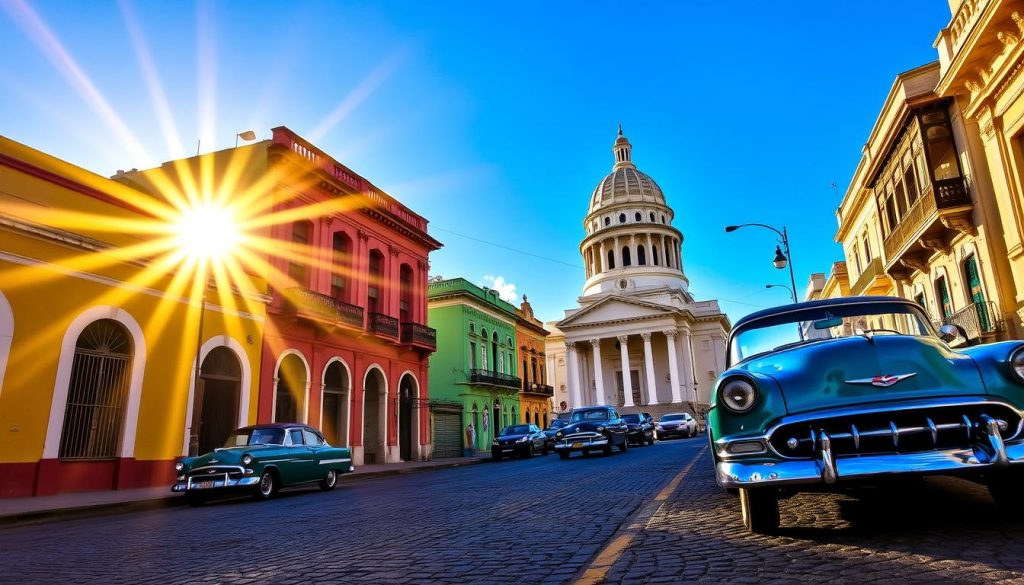
Exploring Old Havana’s historic landmarks and Cuban culture feels like stepping back in time. It’s a UNESCO-protected area that offers a unique look at Havana’s history and life today.
Classic American Cars: Rolling Museum of Havana
Havana’s streets are filled with vintage American cars from the 1950s. These cars are well-kept and add to the city’s charm. They make visitors feel like they’re in a car museum on wheels.
These classic cars include Oldsmobiles, Chevys, Fords, Plymouths, and Buicks. They let people see Havana’s attractions and Cuban culture in a unique way.
Best Places for Car Tours
Travelers can go on guided tours in these vintage cars. They explore Havana’s lively neighborhoods and take amazing photos. In 2019, many visitors chose to rent a classic car and driver.
These tours usually last about 90 minutes. They cost 25-30 CUC per hour.
Photography Opportunities
These classic cars offer endless photo chances. They add color and interest to Havana’s streets. The old cars stand out against the city’s modern backdrop.
They create a fascinating contrast with the city’s architecture and lively Cuban culture.
Historical Significance
Fidel Castro banned foreign car imports after the 1959 revolution. By 1956, Cuba had over 140,000 cars, with 90,000 in Havana. Despite the upkeep challenges, Cubans have learned to keep these cars running.
“Havana’s streets are a rolling museum of classic American cars, a testament to the city’s resilience and the ingenuity of its people.”
The Vibrant Malecón: Havana's Famous Waterfront
The Malecón, or Avenida de Maceo, is a key spot for outdoor adventures and Havana sightseeing. It stretches along Havana’s coast for 5 miles. This place is known for its history, architecture, and lively vibe, attracting both locals and tourists.
When the sun sets, the Malecón buzzes with life. People walk, chat, and enjoy the views of the Caribbean Sea and the city. The area near 23rd Street in Vedado is especially lively, with bars, restaurants, and live music.
| Malecón Highlights | Key Facts |
|---|---|
| Stunning Oceanfront Views | The Malecón stretches along Havana’s coastline for 5 miles. |
| Lively Sunset and Evening Atmosphere | Havana enjoys warm temperatures year-round, ranging from 25-30°C (77-86°F) during the day and 19-25°C (66-77°F) at night. |
| Vibrant Nightlife in Vedado | The Malecón is particularly lively near 23rd Street in the Vedado neighborhood, a modern area with a bustling nightlife scene. |
The Malecón is perfect for a quiet walk, a romantic sunset, or a fun night out. It’s a quintessential part of Havana sightseeing. This iconic promenade lets you dive into Cuba’s rich culture and lively atmosphere.
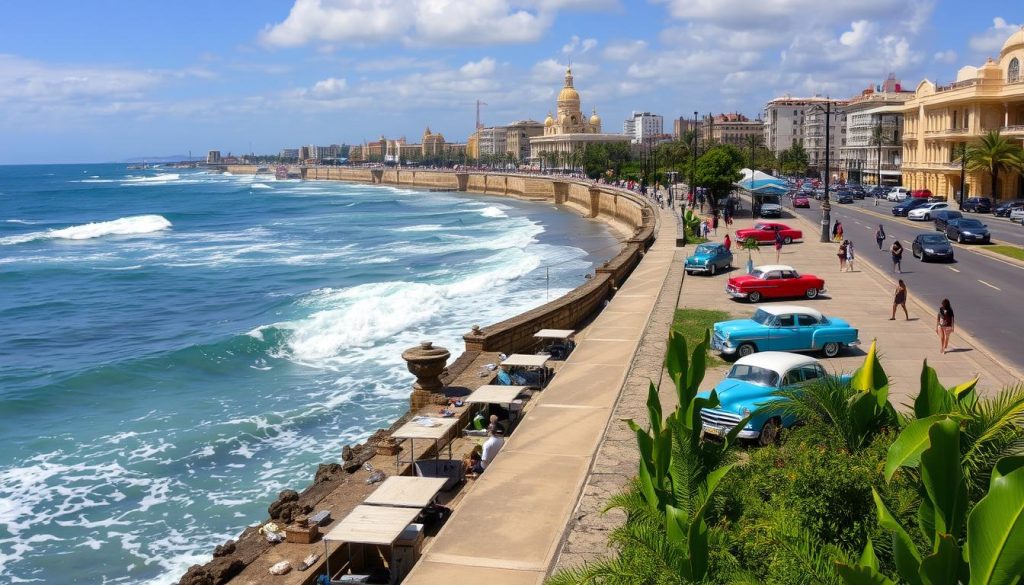
Cultural Immersion: Museums and Art Galleries
Havana is a city full of cultural wonders. Its museums and art galleries are true treasures. Explore the Cuban culture and Havana attractions through these exceptional places.
Museum of the Revolution
The Museum of the Revolution is a key spot. It’s in the old Presidential Palace. Here, you’ll see artifacts and personal items of famous revolutionaries like Che Guevara.
It’s a deep dive into Cuba’s history. You’ll learn about the country’s big change.
Museo Nacional de Bellas Artes
The Museo Nacional de Bellas Artes is Cuba’s biggest art museum. It has a vast collection of Cuban art. You can see everything from old masterpieces to modern works.
These pieces show the Cuban culture in all its beauty.
Contemporary Art Spaces
Havana’s art scene is always changing. Places like La Fábrica de Arte Cubano (FAC) are at the forefront. They show off the newest works by Cuban artists.
“Havana’s museums and art galleries are not merely repositories of the past; they are living, breathing expressions of the city’s resilient spirit.”
Hemingway's Haunts: Literary Legacy in Havana
Discover Ernest Hemingway’s literary legacy in Havana, Cuba. His connection to the island lasted over three decades. His influence is still seen in the city’s landmarks and culture.
Visit the Ambos Mundos hotel in Old Havana. Hemingway stayed here and wrote several famous works, like “The Old Man and the Sea.” See the rooms where he wrote and imagine him at work.
Next, head to Finca Vigía, Hemingway’s old home. Now a museum, it celebrates his life and work. Explore the grounds, see his personal items, and learn about his creative process.
Don’t miss Hemingway’s favorite bars, La Bodeguita del Medio and Floridita. Try a mojito or daiquiri, just like Hemingway. Imagine him writing as he enjoyed these Cuban classics.
“I drink to make other people more interesting.” – Ernest Hemingway
Hemingway’s lasting impact on Havana shows in its historic landmarks and Cuban culture. By following his path, you’ll discover the deep bond between him and the city.
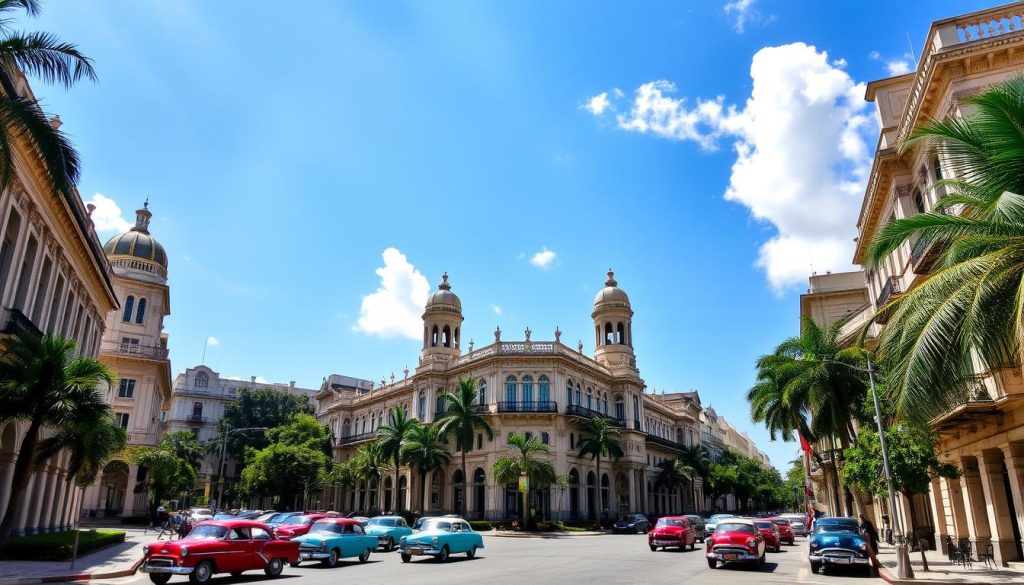
Cuban Nightlife and Entertainment
Havana’s nightlife is a window into Cuban culture. It’s filled with legendary spots like the Tropicana Cabaret and lively salsa venues. The city buzzes with music, showing off Cuba’s rich heritage.
Tropicana Cabaret
The Tropicana Cabaret, opened in 1939, is a top spot for an unforgettable show. It dazzles with Cuban dance, music, and costumes. Guests feel like they’ve stepped back in time to a world of glamour.
Salsa Venues
Salsa is key to Cuban culture, and Havana has many places to enjoy it. The Casa de la Musica is famous for its salsa shows and dance parties. It attracts people from everywhere.
Live Music Spots
Havana celebrates Cuba’s music with many live spots. The Buena Vista Social Club is a highlight, drawing fans with its music. Places like Jardines del 1830 and El Sauce also feature talented musicians.
| Venue | Specialty | Notable Features |
|---|---|---|
| Tropicana Cabaret | Cuban dance and music revue | Established in 1939, spectacular stage shows |
| Casa de la Musica | Salsa music and dance | Popular performances and dance parties |
| Buena Vista Social Club | Live Cuban music | Legendary venue, showcasing talented musicians |
Havana’s nightlife is unforgettable. From the Tropicana Cabaret to salsa and live music, it’s a cultural journey. It leaves a lasting mark on anyone who experiences it.
“The music of Cuba is as diverse as the island itself, with influences from Africa, Spain, and indigenous cultures. It’s a vibrant tapestry that weaves together the past and present, creating a truly unique and captivating experience.”
Havana, Cuba: Best Things to Do - Top Picks
Havana, the vibrant capital of Cuba, is a mix of attractions and culture. You can explore Old Havana, a UNESCO site, or dive into the city’s art scene. Here are the top activities to do in Havana:
- Explore Centro Habana’s historic streets. See local markets, colorful buildings, and lively plazas.
- Ride in a classic American car. It’s a symbol of Havana’s charm and iconic landmarks.
- Walk the Malecón, Havana’s seaside promenade. See the city’s change over the years.
- Visit the Colon Cemetery. It’s a huge necropolis with over 800,000 graves, showing Havana’s history and culture.
- Watch a Cuban baseball game. The Industriales team and fans create an unforgettable atmosphere.
- Discover Havana’s art scene. Visit studios, galleries, and spaces like Fabrica de Arte Cubano.
These activities give you a deep look into Havana’s attractions and culture. You’ll learn about its history, architecture, and modern life.
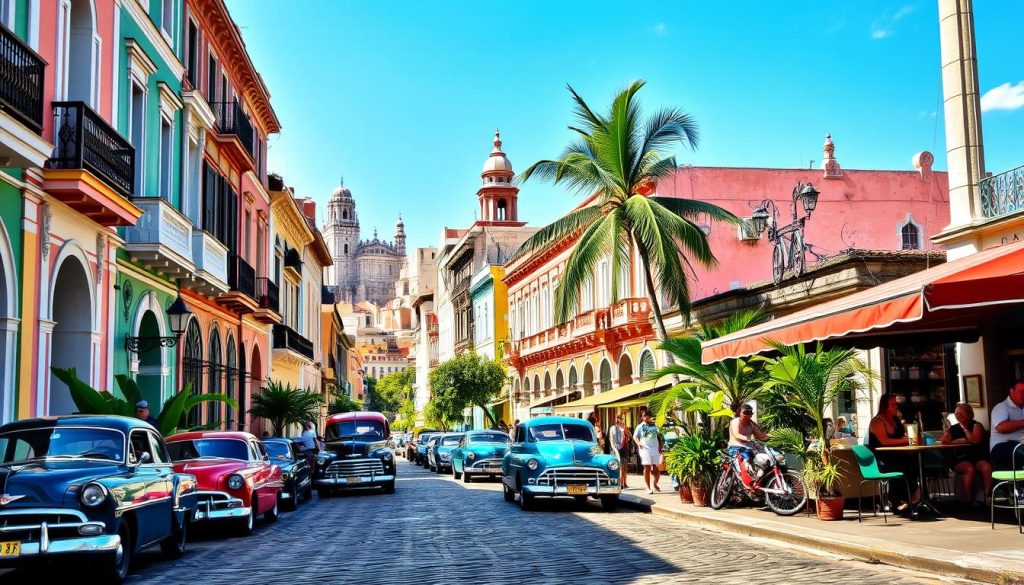
| Activity | Cost | Duration |
|---|---|---|
| Vintage Car Tour | $29 per seat or $99 to rent the whole vehicle | 2-3 hours |
| Colon Cemetery Tour | $5-$10 per person | 1-2 hours |
| Cuban Baseball Game | $1-$5 per ticket | 2-3 hours |
| Fabrica de Arte Cubano Entry | $2-$5 per person | 2-3 hours |
These activities give you a deep look into Havana’s attractions and culture. You’ll learn about its history, architecture, and modern life.
Culinary Adventures: From Paladares to Street Food
Havana’s food scene is full of culinary experiences that show off the lively Cuban culture. Explore the cozy, personal spots of paladares, private restaurants. Here, you can enjoy traditional Cuban dishes with a fresh twist.
For a deeper dive, try a street food tour. You’ll taste treats like churros, chiviricos, and famous Cuban pork sandwiches. Don’t miss Coppelia Ice Cream, a must-visit for its creamy, rich desserts.
Discover the real taste of Cuban cuisine at local markets like Almacenes San José. These markets are full of fresh produce, spices, and handmade goods. They will awaken your taste buds.
| Culinary Highlight | Description |
|---|---|
| Paladares | Intimate, privately-owned in-house restaurants offering personalized service and traditional Cuban cuisine with a modern twist. |
| Street Food Tours | Immersive experiences that allow you to sample local delicacies like churros, chiviricos, and the iconic Cuban pork sandwiches. |
| Coppelia Ice Cream Parlor | A beloved Havana institution serving up creamy, indulgent ice cream treats. |
| Almacenes San José Market | A vibrant local market where you can uncover the authentic flavors and ingredients that define Cuban cuisine. |
Havana has something for every food lover, from fancy dinners to casual outings. Dive into the rich tastes and lively vibes that make this city a top food spot.
Tobacco Heritage: Cigar Factory Tours
Havana’s cigar factories give a peek into Cuba’s tobacco history. You’ll see the art of cigar-making up close. Skilled torcedores (cigar rollers) and premium tobacco leaves are part of the magic.
Famous Factories
The Romeo y Julieta/H. Upmann Factory and the Partagás Factory are famous in Havana. These places are full of history. They let visitors see how the world’s best cigars, like Cohiba, are made.
Cigar Rolling Process
- Watch as torcedores pick and mix the finest tobacco leaves.
- See how cigar rollers shape and wrap cigars by hand.
- Learn about the factory readers who read to workers while they rolled.
Shopping Tips
After the tour, you can buy cigars at the factory shops. Prices might be higher than street vendors, but the quality is sure. Ask the staff for advice to find the best deal for your Cuban culture experience.
“Smoking a good cigar is like a temporary going home to some place you can’t recall, but you know it’s getting familiar.”
– Gavin MacLeod
Beach Escapes: Playas del Este
Just a short 20-minute drive east of Havana, Playas del Este offers a peaceful escape. This area has seven unique beaches along a 9-mile stretch. It’s a chance to see a more authentic Cuban beach vibe, away from Varadero’s crowds.
Getting to Playas del Este is easy. You can take a private taxi or a local bus. The main beach, Santa Maria del Mar, is just $5 from Old Havana by bus. A private taxi costs around $17.
Playas del Este has beaches for everyone. Snorkel at Playa Bacuranao or try watersports at Playa Megano. Don’t miss Playa Marazul, the best beach here, or the family-friendly Santa Maria del Mar. Playas del Este is perfect for a day of relaxation or adventure, making your Outdoor adventures in Cuba unforgettable.
